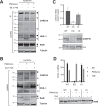CARD10 cleavage by MALT1 restricts lung carcinoma growth in vivo
- PMID: 33824280
- PMCID: PMC8024357
- DOI: 10.1038/s41389-021-00321-2
CARD10 cleavage by MALT1 restricts lung carcinoma growth in vivo
Abstract
CARD-CC complexes involving BCL10 and MALT1 are major cellular signaling hubs. They govern NF-κB activation through their scaffolding properties as well as MALT1 paracaspase function, which cleaves substrates involved in NF-κB regulation. In human lymphocytes, gain-of-function defects in this pathway lead to lymphoproliferative disorders. CARD10, the prototypical CARD-CC protein in non-hematopoietic cells, is overexpressed in several cancers and has been associated with poor prognosis. However, regulation of CARD10 remains poorly understood. Here, we identified CARD10 as the first MALT1 substrate in non-hematopoietic cells and showed that CARD10 cleavage by MALT1 at R587 dampens its capacity to activate NF-κB. Preventing CARD10 cleavage in the lung tumor A549 cell line increased basal levels of IL-6 and extracellular matrix components in vitro, and led to increased tumor growth in a mouse xenograft model, suggesting that CARD10 cleavage by MALT1 might be a built-in mechanism controlling tumorigenicity.
Conflict of interest statement
The authors declare no competing interests.
Figures




References
-
- Taniguchi K., Karin M. NF-κB, inflammation, immunity and cancer: coming of age. Nat. Rev. Immunol. (2018). 10.1038/nri.2017.142. - PubMed
LinkOut - more resources
Full Text Sources
Other Literature Sources
Molecular Biology Databases
Research Materials

